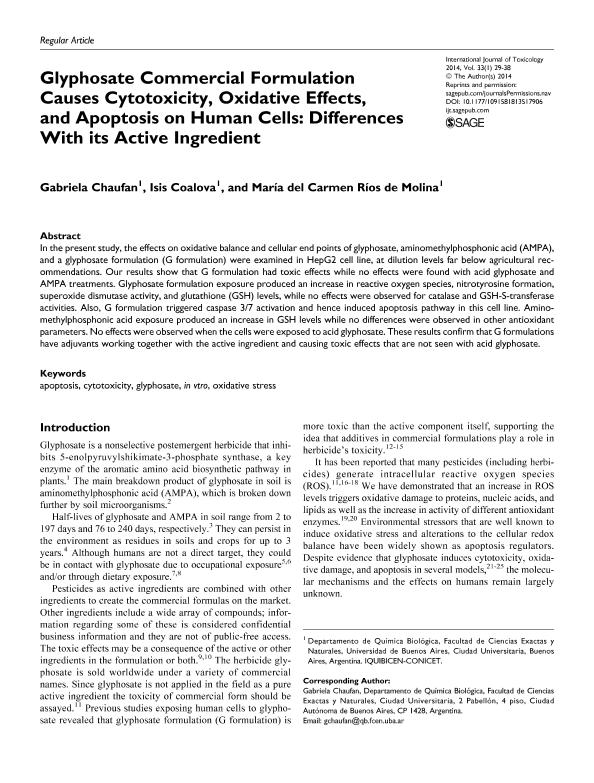Artículo
Glyphosate commercial formulation causes cytotoxicity, oxidative effects, and apoptosis on human cells: Differences with its active ingredient
Fecha de publicación:
01/2014
Editorial:
SAGE Publications
Revista:
International Journal of Toxicology
ISSN:
1091-5818
Idioma:
Inglés
Tipo de recurso:
Artículo publicado
Clasificación temática:
Resumen
In the present study, the effects on oxidative balance and cellular end points of glyphosate, aminomethylphosphonic acid (AMPA), and a glyphosate formulation (G formulation) were examined in HepG2 cell line, at dilution levels far below agricultural recommendations. Our results show that G formulation had toxic effects while no effects were found with acid glyphosate and AMPA treatments. Glyphosate formulation exposure produced an increase in reactive oxygen species, nitrotyrosine formation, superoxide dismutase activity, and glutathione (GSH) levels, while no effects were observed for catalase and GSH-S-transferase activities. Also, G formulation triggered caspase 3/7 activation and hence induced apoptosis pathway in this cell line. Aminomethylphosphonic acid exposure produced an increase in GSH levels while no differences were observed in other antioxidant parameters. No effects were observed when the cells were exposed to acid glyphosate. These results confirm that G formulations have adjuvants working together with the active ingredient and causing toxic effects that are not seen with acid glyphosate.
Palabras clave:
APOPTOSIS
,
CYTOTOXICITY
,
GLYPHOSATE
,
IN VTRO
,
OXIDATIVE STRESS
Archivos asociados
Licencia
Identificadores
Colecciones
Articulos(IQUIBICEN)
Articulos de INSTITUTO DE QUIMICA BIOLOGICA DE LA FACULTAD DE CS. EXACTAS Y NATURALES
Articulos de INSTITUTO DE QUIMICA BIOLOGICA DE LA FACULTAD DE CS. EXACTAS Y NATURALES
Citación
Chaufan, Gabriela; Coalova, Isis; Rios, Maria del Carmen; Glyphosate commercial formulation causes cytotoxicity, oxidative effects, and apoptosis on human cells: Differences with its active ingredient; SAGE Publications; International Journal of Toxicology; 33; 1; 1-2014; 29-38
Compartir
Altmétricas




